George Florence and 70mm at The Astor, Melbourne, Australia |
Read more at in70mm.com The 70mm Newsletter |
| Written by: Erick White, Melbourne, Australia | Date: 03.10.2015 |
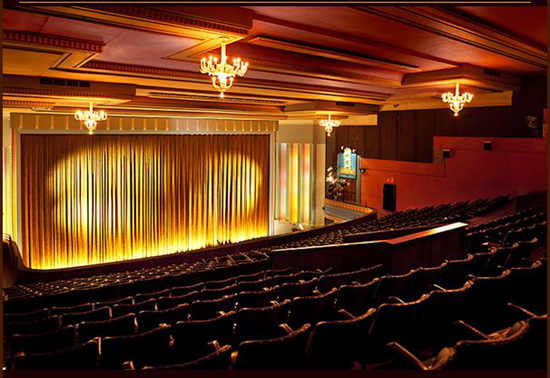 Melbourne, Australia, is home to one of
the world's unique cinemas, The Astor. It was built in 1936 in the
city's inner suburbs in an Art-Deco style and has hardly beeen altered
since then. It has been run since 1982 by George Florence, a man with an
outstanding love for 70mm presentation. The theatre has become over the
decades a world-leader in the presentation and nurture of the 70mm
medium. Melbourne, Australia, is home to one of
the world's unique cinemas, The Astor. It was built in 1936 in the
city's inner suburbs in an Art-Deco style and has hardly beeen altered
since then. It has been run since 1982 by George Florence, a man with an
outstanding love for 70mm presentation. The theatre has become over the
decades a world-leader in the presentation and nurture of the 70mm
medium.George's family has a very strong background in the cinema business and ran a chain of Greek language in Melbourne in the 1960s and 70s. (Melbourne has the world's largest Greek population outside Greece. George grew up learning all aspects of the cinema business and became a projectionist at one of Melbourne's larger downtown cinemas. While still in his twenties, he was offered the opportunity to take over the Astor cinema in St Kilda by an uncle and from 1982 ran a repertory screening policy, with a fresh double bill everynight. There was a mixture of classsic movies, reltively new releases and imaginative double features. The projection equipment was more or less original to the theatre, with Australian-made Cummings and Wilson projector heads, Westrex sound, with "üniversal" bases and Peerless Carbon arc lamps. It is still on display in the theatre foyer. One of the early features offered was HOW TO MARRY A MILLIONAIRE. Somewhere an original four-track magnetic print had been found and the movie was presented with stereophonic sound, temporarily installed. This was an indication of things to come. In 1985 George purchased a pair of Cinemeccanica Victoria Eight 70/35 projectors. They were installed together with a large screen placed in front of the original proscenium surrounded by new curtains. The screen was over forty feet wide and came from one of Melbournes prestige cinemas, The Bercy. The original screen and proscenium are still in place behind it all. This was the first significant alteration to the cinema since it had been built in the late 1930s. The six-track sound system was custom built by a local cinema technician, Ron Haymes. Later on, a Dolby CP500 would be installed. The Cinemeccanica projectors were from a former Melbourne drive-in theatre. They dated from the mid 1960s and had done relatively little work, though they had been used for 70mm projection from time to time. |
More in 70mm reading: 70mm Cinema and Film in Australia 70mm Films in Sydney The Lost World of 70mm Theatres Cinerama at the Melbourne Plaza Internet link: • The Astor Theatre • 35mm and 70mm Prints • Chappel Distribution • potentialfilms.com Clarification: Just to clarify something, my company Potential Films imported the Tati films, including the 70mm print on loan of "PLAYTIME" from France for the Astor screenings. We had hopes of using it elsewhere but found no takers. CHAPEL DISTRIBUTION is a company established jointly by myself and George Florence. This and some other pieces I’ve seen often seem to imply that every vintage or 70mm print screened by the Astor is supplied by Chapel or some mysterious library owned by the Astor itself. Not exactly the case! George however has been instrumental in many of the major distributors keeping their 70mm prints available by his regular bookings at the Astor. It is unlikely there would be any 70mm prints left in Australia without the dedication of the Astor to keep them screening. Mark Spratt Director Potential Films |
|
One of the early 70mm seasons was the screening of the restored 70mm version of SPARTACUS, which did excellent business over several nights, indicating that a market for 70mm projection still existed. George Florence then worked assiduously to build up this following, as well as to provide other up-market presentations in 35mm such as a four-track reprint of WEST SIDE STORY and four-track screenings of THE BLUES BROTHERS. George kept abreast of further developments in sound reproduction such as the various digital systems. He installed a DTS time-code reader for 70mm prints and cyan analogue soundtrack scanners as well. In recent years acoustic dampening has been applied to the auditorium walls to make the theatre less reverberant. A brand-new twenty metre wide matte screen was installed in 1995, a few feet in front of the earlier 40 foot screen. New screen drapery was also fitted. The Astor's daily programme changes made it impractical to install a platter system and to this day film programmes are run on spools with reel changeovers. The Astor has shown 3D movies occasionally in recent years, using the single film technology and Polaroid glasses. About ten years ago a special highly reflective 4x3 3D screen was constructed to be placed in front of the normal matte screen. A number of classic 3D movies from the early 1950s were presented, including DIAL M FOR MURDER and HOUSE OF WAX. There seems to be little enthusiasm for recent-release 3D movies. |
|
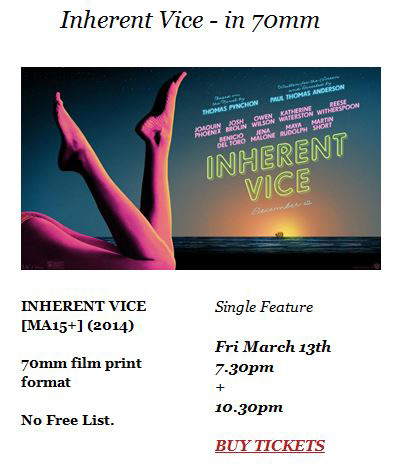 Over the years, a repertoire of about twenty 70mm prints has has been
built up, with the occasional importation of prints for specialty
seasons. Among the regular showings are HAMLET, BEN-HUR, THE RIGHT STUFF
and SPACE ODYSSEY. About six 70mm screenings are included in each
three-month calendar period. Recent 70mm programmes have included
INTERSTELLAR and INHERENT VICE (a rare coup at short notice). Other
special seasons have included PLAYTIME and MAD MAD WORLD, which was an
Ultra Panavision squeezed print. Special projection lenses were imported
and the effect was stunning. Over the years, a repertoire of about twenty 70mm prints has has been
built up, with the occasional importation of prints for specialty
seasons. Among the regular showings are HAMLET, BEN-HUR, THE RIGHT STUFF
and SPACE ODYSSEY. About six 70mm screenings are included in each
three-month calendar period. Recent 70mm programmes have included
INTERSTELLAR and INHERENT VICE (a rare coup at short notice). Other
special seasons have included PLAYTIME and MAD MAD WORLD, which was an
Ultra Panavision squeezed print. Special projection lenses were imported
and the effect was stunning.The Astor saw the usefulness of electronic projection for limited purposes about fifteen years ago. Though crude by modern standards the screen results were quite good, though not adequate for feature presentation. It was used, for example, to show a Jacques Tati television short (Night Class) with a season of PLAYTIME. The Astor imported a 70mm print of this film in the early 2000s. It was one of the last 70mm prints to carry magnetic soundtracks. The carefully cultivated Astor 70mm audience loved the movie and it did well. The digital connection continued and about six years ago a Sony 4K digital projector was temporarily installed to present a season of BLADE RUNNER. Once again, the sophisticated Astor clientele reacted positively to this innovation, the first 4K presentation in Melbourne. The screen results were extremely good, with a brilliant, crisp rock-steady image on the full width of the twenty- metre screen. Consequently a Barco 4K DLP projector was installed, again with extremely good screen results. The Astor programming took advantage of the greater amount of movie title availability with the widespread introduction of digital distribution. 35mm prints were still used when available, but the majority of screenings were digital. Now the Astor had a bigger repertoire than ever. Alongside with the Astor Cinema goes Chapel Film Distribution, which is also owned by George Florence. It has long specialised in excellent vintage titles, especially musicals, and handles the 70mm prints as well. It continues to supply the new management of the theatre. The Astor has not ignored front-of-house matters and has run an excellent candy bar, famous for its chocolate cone ice-creams and its gateaux. Light alcoholic drinks are also available. It is a welcome contrast to conventional multiplex candy bar fare. Nor did the Astor skimp on front-of-house staff numbers, unlike many a multiplex. |
|
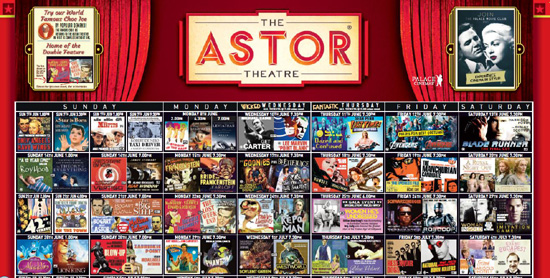 A
large factor in the Astor's success is its elaborate glossy full-colour
quarterly calendars. They are the size of a one-sheeter cinema poster and
each programme day has its own carefully-chosen art work. On the back of the
calendars each movie has its own mini-critique, complete with running time
and technical details such as "4K" presentation, digital sound, "six track
magnetic stereo" and "dye-transfer print". The Astor's customers have been
educated to know what these cryptic comments mean, and appreciate them.
These calendars have been mailed to subscribers and have also been available
outside the theatre on a sidewalk stand, as well as in the theatre foyer The
programmes are also available on the Internet. A
large factor in the Astor's success is its elaborate glossy full-colour
quarterly calendars. They are the size of a one-sheeter cinema poster and
each programme day has its own carefully-chosen art work. On the back of the
calendars each movie has its own mini-critique, complete with running time
and technical details such as "4K" presentation, digital sound, "six track
magnetic stereo" and "dye-transfer print". The Astor's customers have been
educated to know what these cryptic comments mean, and appreciate them.
These calendars have been mailed to subscribers and have also been available
outside the theatre on a sidewalk stand, as well as in the theatre foyer The
programmes are also available on the Internet.About ten years ago the freehold of the Astor building was purchased by the private school next door. It had vague plans to develop the building, but they never materialised and George Florence continued his lease. Then, two years ago the building was sold to a private businessman with a background in the cinema business and things looked set to carry on as before. Difficulties arose, however, and the Astor mangement decided not to renew its lease after April 2015. It seemed that The Astor could well be lost to Melbourne, but an up-market Australian Cinema Chain called Palace Theatres stepped in to take over the cinema, promising to run it pretty much as it always has been. After having been closed for refurbishment for six weeks, the Astor reopened its doors in late June [2015]. Customers do not seem to notice any great change, which is very welcome to the Astor's loyal customers. A new calendar has been issued, with a quota of 70mm screenings and the famous ice-creams are as good as ever. |
|
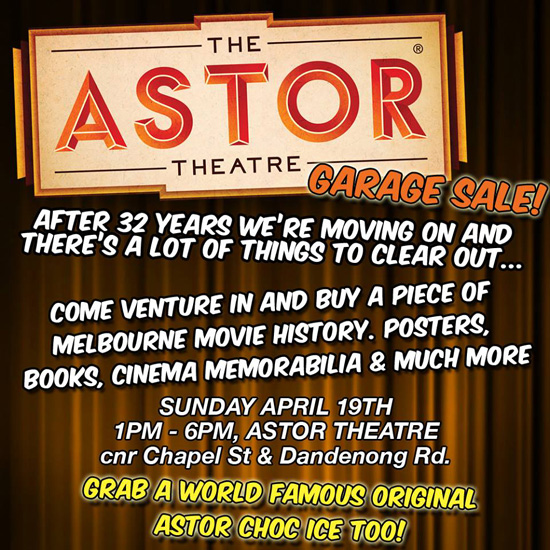 Join
us on Sunday April 19th from 2pm to 5pm for a grand garage sale of books,
posters, memorabilia and general cinema related items. Our candy bar will be
open - one last chance for Astor Choc Ices! e-Newsletter 14.04.2015 Join
us on Sunday April 19th from 2pm to 5pm for a grand garage sale of books,
posters, memorabilia and general cinema related items. Our candy bar will be
open - one last chance for Astor Choc Ices! e-Newsletter 14.04.2015George Florence, the cinema's long-time proprietor, has a deep passion for film in general and 70mm presentation in particular. He considers film to be superior as a medium to anything similar, particularly in the area of sound reproduction. Magnetic analogue recording and reproduction gives superior results to digital processes. Many digital remixes are inferior and George fears that unique original four and six track mixes for classic films may be lost. The original six-track sound for LAWRENCE OF ARABIA has never been bettered, he believes and he laments the disappearance of of a rare print in Korea. He considers it vital for original prints to be preserved. For thirty years George has communicated his passion to the Astor's audience and Melbourne's cinema goers are much in his debt. We are lucky to have a cinema institution that seems to be almost unique, with its strong record of 70mm screenings, perhaps the best in the world. |
The Astor had a great farewell, with full
houses for the last couple of days. A friend of mine took his kids to
the SOUND OF MUSIC screening and it had capacity business. George
himself was seen in the candy bar making ice-cream cones in order to
keep up with the demand. I trust that by now he has recovered from the
closing. Apart from the sheer hard work, I think it would have been
emotionally taxing. Eric White |
The Background Situation – Until April 2nd this was the postion: |
|
|
The landlord, Ralamar Nominees, will not renew our lease, which expires in May this year. Although we have tried every avenue to secure the business you know as The Astor Theatre, all attempts have failed and we must now resign ourselves to the fact that our last scheduled screening will be on April 5th 2015, as per the current calendar. We were very disappointed that there was no support offered from any wealthy arts benefactor or organisation (that can purchase the freehold property) nor any attempt by a Government or Council agency to avert the inevitable demise of The Astor Theatre. Once The Astor closes it is gone forever and will not be possible to resuscitate it as you know it – there may be a cinema operating in that space – but it won’t be The Astor – as we will be gone. To be clear we should point out the distinction between the business you know as The Astor Theatre – and the building. The Astor Theatre is the business operating within the building located at 1-3 Chapel Street St Kilda. The business owns the Registered TradeMark “Astor” – it is our identity and all the goodwill generated over the past 32 years of operation resides in that name. We rent the space within the building from the landlord. Our business also owns all the infrastructure and plant and equipment in use to run The Astor. We set up the Friends of the Astor to be a vocal group of supporters of the business known as The Astor Theatre. Unfortunately there has been a shift of philosophy within that organisation’s committee and they no longer consider that they are there to protect The Astor Theatre – but to protect the premises it operates out of. There may be an 11th hour reprieve in that another cinema operator may offer suitable arrangements to acquire our business and a new lease from the landlord, as unfortunately up to now this has not transpired — we will inform you as soon as anything changes, if it does. |
|
Background |
|
|
Not only that, the site that The Astor stands on was previously occupied by an earlier movie theatre called the Diamond (later the Rex) that started showing movies around 1908 (the very beginnings of the movie industry itself) — one of the first suburban “hard–top” cinemas in Melbourne’s St Kilda — the hub of this city’s entertainment from its formation. Furthermore, we are committed to film. While there is a rush towards switching to a fully digitized projection system in cinemas, and although we do screen the very best in digital alongside film, we believe that the Astor must remain a working film cinema museum and be capable of presenting real film projection. With our own library of more than 600 film prints – the largest private film print archive in Australia – (35mm, 16mm and 70mm) we are well positioned to ensure that the Astor can continue to present the cinema experience it was built for — to recognise the importance of such edifices as the prime source of public entertainment, and a social focal point, before the days of TV and the myriad other forms of entertainment. These are some of the reasons The Astor was classified by the National Trust and Heritage Victoria. While Heritage Victoria and The National Trust do fine jobs in protecting The Structure – they DO NOT protect the use of the building. This is where your voice is important to convince politicians and prospective new tenants that inappropriate development (except for obvious repairs to damaged parts of the building) will not be welcomed, and that it is important to maintain the use of the building AS IT IS. |
|
Palace Cinemas Announcement
|
|
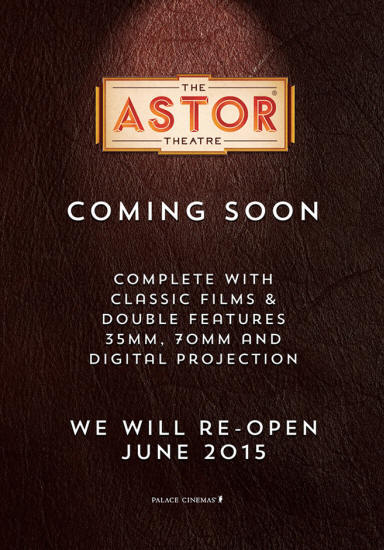 A
huge thank you from the well of our collective Astor hearts to all of our
wonderful patrons who have made the Astor Experience so soulful throughout
our tenancy. We are forever indebted to you for your love and support and we
want to say our final thank you as we now hand over the reigns to Palace
Cinemas. After a brief period of refurbishment, the venue will re-open the
venue under their management in June. e-News 28.04.2015 A
huge thank you from the well of our collective Astor hearts to all of our
wonderful patrons who have made the Astor Experience so soulful throughout
our tenancy. We are forever indebted to you for your love and support and we
want to say our final thank you as we now hand over the reigns to Palace
Cinemas. After a brief period of refurbishment, the venue will re-open the
venue under their management in June. e-News 28.04.2015Palace Cinemas are thrilled to announce that they have reached an agreement to secure the future operation of the Astor Theatre, as Melburnians know and love it. The Astor will be open this Easter weekend as per the current calendar and will then close for a short period for essential maintenance and repairs. The theatre will re-open in June 2015 with a gala event and an exciting new calendar – all of which will be announced next week. Under Palace’s custodianship the Astor will continue operating as a single-screen, 1,150 seat auditoria, with its well-regarded programming of both new release and classic films intact and showing on 35 and 70 millimetre prints as well as 2K and 4K digital projection. Benjamin Zeccola, Palace Cinema’s CEO says of the plans: “Palace Cinemas are keenly aware of the importance in preserving The Astor experience and, to that end, we see the business operating very much as it does today: one cinema, the continuation of the brilliant programming and maintaining the building in the art deco style in direct consultation with Heritage Victoria.” George Florence, proprietor since 1982, and creator of the unique programming and operational style, says he is delighted his legacy will continue and states: “I am very grateful that we have found a solution to keeping The Astor Theatre operating indefinitely, after a long period of great uncertainty, and that Palace Cinemas are pledging to maintain The Astor Experience, that so many loyal patrons hold so dearly. We are sure there will be a great sigh of relief to this positive news and we look forward to a greater Astor Theatre” Melbourne has seen thirty-two years of the finest repertory programming and the very best in film and now digital presentation thanks to founder George Florence. The Astor is so much more than just the bricks and mortar that has become Melbourne’s spiritual home for film. |
|
| Go: back - top - back issues - news index Updated 22-01-25 |
